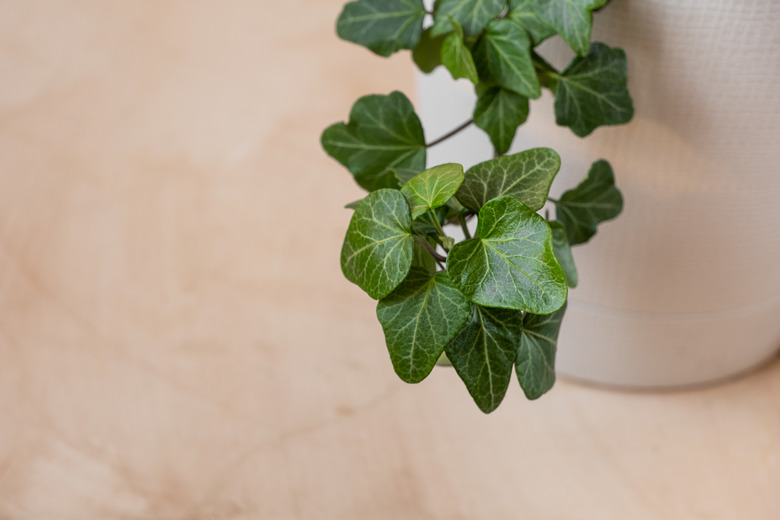Why Would An Ivy Plant's Leaves Start To Turn Yellow?
We may receive a commission on purchases made from links.
It's easy to forget that a potted ivy plant is a living thing with strong preferences about the environment in which it lives. It likes water but not too much. It wants to be warm but not hot and certainly not drafty. All this is to say that it's easy to mess up the mix sometimes, and your plant will let you know. Those yellow leaves are your ivy telling you that it's suffering from environmental stress or other issues.
Tip
Often, yellowing leaves are from overwatering or from excessively bright light. Direct sunlight and waterlogged soil are big problems for ivy plants, but these problems are easily solved.
Don’t Water Too Much
Don't Water Too Much
A frequent culprit for yellowing leaves on ivy plants is excess water. Ivy plants like to dry out a little between waterings. If you stick your finger into the soil near the roots, you want it to be dry about 25 percent of the way down the roots. This is when to water it, and when watering the plant, it'll take just what it needs, and the rest will drain out the bottom into the saucer. Empty this excess water.
If you say, "What saucer?" and your plant pot doesn't have drainage holes, then that's a problem. Ivy requires well-draining soil because if the roots are sitting in water (called having "wet feet"), then the roots begin to rot, and the plant may eventually die.
Don't get into a habit of thinking that watering once a week is the way to go because humidity in the air is constantly in flux too, so the plant can dry out as quickly in the winter as it does in a summer heatwave. The finger-in-the-soil trick is the best metric. Ivy enjoys a spritz from a water mister too, especially as this can keep spider mites at bay.
Get the Environment Right
Get the Environment Right
Most ivy plants like sunlight, even bright light, and although they tolerate a fair amount of dappled sun or partial shade, they won't do as well in low light. If leaves are yellowing, burning or bleaching, it can be related to sunlight — getting too much for too long, or getting too little. You'd be amazed at what moving a plant 3 feet away can do for it. Try standing in a bright window and then stepping just outside the frame — big difference, isn't it?
Variegated ivy plants aren't wild about direct sunlight, because this can burn the lighter-colored parts of their leaves. Just shimmy it away from sunbeams so it's in bright light, not blinding. It wants bright to medium light through to bright indirect light; direct light can burn the leaves, and too little light will cause yellowing. If you try a new spot, you'll generally know by the end of the first week how your plant is liking it; just look for signs like new growth or yellowing leaves.
Similarly, don't put ivy near a heat vent or a window that you open on a regular basis. You might enjoy the breeze or the crackling fireplace, but your ivy wants a nice, stable, mild climate.
Bugs and Other Natural Factors
Bugs and Other Natural Factors
Once an ivy gets weakened via environmental stress or watering issues, it becomes susceptible to infestation from spider mites, scale, mealybugs and other pests. Pest control may or may not be able to reverse an infestation. Don't give up yet, though, because there's still hope for a dying ivy plant. Nutritional deficiency in soil can contribute to pests as well, so stay on top of fertilizing.
Remember that leaves don't stay healthy forever. Eventually, they wither and die, new ones replace them and the plant circle of life continues. The "normal" yellowing happens if there is new growth throughout the plant, and older, larger leaves begin to yellow as they begin their death cycle. This usually happens with leaves at the bottom of the plant.
As the yellowing takes over a leaf, you can simply pinch off the leaves and redirect food and energy to the newer, younger growth.
